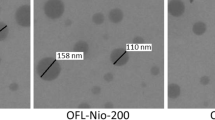Abstract
Aim
In this study, we utilized a micelle–clay complex composed of the surfactant octadecyltrimethylammonium bromide and montmorillonite clay and evaluated its antibacterial effects.
Methods
Using Pseudomonas aeruginosa, Staphylococcus epidermidis, and Micrococcus luteus, bactericidal assays were performed to determine the effects of ODTMA-clay complex on the viability of bacterial pathogen at various doses and different intervals of time. Cytotoxicity assays were performed to investigate ODTMA-clay complex effects on human cells, as determined by release of intracellular lactate dehydrogenase.
Results
The results revealed that ODTMA-clay complex abolished bacterial viability at 100 μg/mL within 45 min against P. aeruginosa, S. epidermidis, and M. luteus. Cytotoxicity assays revealed that ODTMA-clay complex exhibited minimal toxicity of the human cells.
Conclusion
Rapid and potent antibacterial effects of ODTMA micelle–clay complex were observed in vitro; however, research is needed to determine precise formulation of contact lens disinfectants comprising ODTMA micelle–clay complex. Additionally, studies should be conducted using in vivo models of keratitis, progressing to pre-clinical and clinical trials. ODTMA micelle–clay complex is an ideal candidate to be incorporated in a novel contact lens disinfectant given the cost-effectiveness and ease of application and can be incorporated as an effective preventative strategy.


Similar content being viewed by others
References
Hilliam Y, Kaye S, Winstanley C (2020) Pseudomonas aeruginosa and microbial keratitis. J Med Microbiol 69:3–13
Lakhundi S, Siddiqui R, Khan NA (2017) Pathogenesis of microbial keratitis. Microb Pathog 104:97–109
O’Callaghan R, Caballero A, Tang A, Bierdeman M (2019) Pseudomonas aeruginosa keratitis: protease IV and PASP as corneal virulence mediators. Microorganisms 7(9):e281
Egrilmez S, Yildirim-Theveny Ş (2020) Treatment-resistant bacterial keratitis: challenges and solutions. Clin Ophthalmol (Auckland, NZ) 14:287
Nir S, Brook I, Anavi Y, Ryskin M, Ben-Ari J, Shveky-Huterer R, Etkin H, Zadaka-Amir D, Shuali U (2015) Water purification from perchlorate by a micelle–clay complex: laboratory and pilot experiments. Appl Clay Sci 114:151–156
Siddiqui R, Khamis M, Ibrahim T, Khan NA (2020) Neuropathogens and nasal cleansing: use of clay montmorillonite coupled with activated carbon for effective eradication of pathogenic microbes from water supplies. ACS Chem Neurosci 11(18):2786–2788
Akbar N, Khan NA, Sagathevan K, Iqbal M, Tawab A, Siddiqui R (2020) Gut bacteria of Cuora amboinensis (turtle) produce broad-spectrum antibacterial molecules. Sci Rep 9(1):17012
Collier SA, Gronostaj MP, MacGurn AK, Cope JR, Awsumb KL, Yoder JS, Beach MJ (2014) Estimated burden of keratitis—United States, 2010. MMWR Morb Mortal Wkly Rep 63(45):1027
Khamis M, Karaman R, Qurie M, Abbadi J, Nusseibeh S, Manassra A (2012) Performance of micelle-clay filters for removing pollutants and bacteria from tertiary treated wastewater. J Environ Sci Eng A 1:160–168
Qurie M, Khamis M, Manassra A, Ayyad I, Nir S, Scrano L, Bufo SA and Karaman R (2013) Removal of Cr (VI) from aqueous environments using micelle-clay adsorption. The Sci World J 942703
Funding
The author(s) disclosed receipt of the following financial support for the research, authorship, and/or publication of this article: American University of Sharjah and University of Sharjah.
Author information
Authors and Affiliations
Contributions
RS and NAK conceived the idea amid discussions with MK, TI and MA. RAS and NA carried out all experiments under the supervision of RS and NAK. NA and RS prepared the first draft of the manuscript. NAK corrected the manuscript. All authors approved the final manuscript.
Corresponding author
Ethics declarations
Conflict of interest
Author RS declares that she has no conflict of interest. Author MK declares that he has no conflict of interest. Author TI declares that he has no conflict of interest. Author NA declares that he has no conflict of interest. Author RAS declares that she has no conflict of interest. Author MA declares that he has no conflict of interest. Author NAK declares that he has no conflict of interest.
Ethical approval
No humans or tissues were used in this research. No animals were involved in this research.
Additional information
Publisher's Note
Springer Nature remains neutral with regard to jurisdictional claims in published maps and institutional affiliations.
Supplementary Information
Below is the link to the electronic supplementary material.
Rights and permissions
About this article
Cite this article
Siddiqui, R., Shah, R.A., Akbar, N. et al. Antibacterial effects of octadecyl trimethylammonium micelle–clay complex against bacterial eye pathogens: potential as a contact lens disinfectant. Int Ophthalmol 42, 939–944 (2022). https://doi.org/10.1007/s10792-021-02075-7
Received:
Accepted:
Published:
Issue Date:
DOI: https://doi.org/10.1007/s10792-021-02075-7




